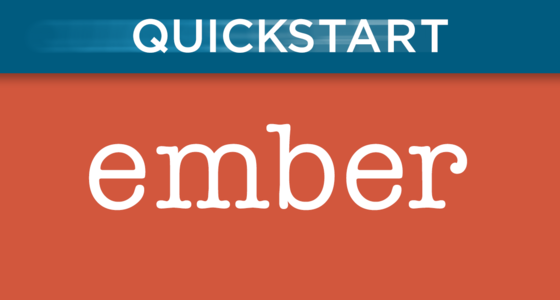Ember Quickstart
A quick introduction to Ember.js, with a focus on Routing and Components
-
Ember QuickstartPhilosophy of Ember
Ember aims to be a complete and holistic solution to building complex single-page web applications. We'll discuss the advantages and challenges of working within Ember's opinionated and convention-oriented ecosystem, point out where Ember aligns with web standards, and enumerate some of the most recent features that have been added to the framework over the past year.
-
Ember QuickstartCreating an App
We'll go through the quick and easy process of creating an ember app with the official build tool, ember-cli, and look at the code that's generated for us automatically.
-
Ember QuickstartTemplates & Simple Helpers
If we start to add content to our project's
application.hbsfile, we can see that Handlebars templates are really just a superset of HTML. By combining data binding with Handlebars helpers it's easy to see how much power there is in the framework's declarative templating features. -
Ember QuickstartExercise: Build a Handlebars Helper
Simple handlebars helpers are often just a thin wrapper on top of a pure JavaScript function. We'll build a helper of our own, using both positional and named arguments, and use it in our Handlebars templates.
-
Ember QuickstartComponents & Actions
Components, or an analogous concept, are at the center of every popular single-page application framework. By encapsulating layout structure (HTML), style (CSS) and behavior (JS) as re-usable building blocks, we free ourselves from having to focus on large and small-scale development simultaneously. We'll cover the most fundamental aspects of Ember's component model, including data binding, lifecycle hooks and actions.
-
Ember QuickstartExercise: A Simple Component
We'll build a simple component together: a custom textarea-like field with a built-in markdown preview feature, using action and data binding,
-
Ember QuickstartComputed Properties
Computed properties are cached, lazily-evaluated values, which are very often derived from other values. We'll take a quick peek at Ember's internal implementation for computed properties, and build a few different examples together.
Finally, we'll explore the concept of computed property macros -- functions that return a computed property -- which provide an easily testable, reusable and parameterized calculation.
-
Ember QuickstartExercise: Image with Caption Component
We'll use the Handlebars helpers that we made earlier, in the context of a slightly more complicated Ember component. This will require use of computed properties as well, in order to handle some "empty" cases (where the component is not given an important value) gracefully.
-
Ember QuickstartLunch
Break for Lunch
-
Ember QuickstartRouting
So far our app isn't very interesting, because it's just a single view. Single-Page App routing allows us to create a multi-page, URL-driven experience, without true page load. We'll discuss an effective mental model for routes as a hierarchy and the router as a finite-state machine in order to understand how a given URL results in a particular set of templates being shown on the screen.
We'll also talk about the router's promise-aware hooks, which make it easy to instruct Ember to wait for an asynchronous process to complete before proceeding to render something on the screen.
-
Ember QuickstartExercise: A Route Hierarchy & Top-Level Templates
We'll build a simple routing structure, including a master-detail layout to touch on some important conceptual and technical key ideas that pertain to Ember's routing layer. This exercise will include
- Child views rendered in a parent's outlet
- queryParams
- Transitions between different routes, and within the same route (just changing data)
-
Ember QuickstartExercise: Out with the Fixture Data
So far, our app has been using fixture data, and this exercise is all about replacing that with data retrieved from an API. Use either ajax, fetch or ember-data to retrieve real blog posts and comments from our workshop API.
-
Ember QuickstartRetrieving & Managing Data
Connecting to real data from an API is something nearly all apps need to worry about, and we'll tackle this concept in three ways.
- First, we'll use ajax in a promise-aware router hook to prove that eventual values (Promises) are handled just as easy as immediate values
- Next, we'll alter our approach to make it server-side rendering friendly, and use a
fetchpolyfill that'll work equally well in Node.js and in the browser - Finally, we'll move away from making explicit requests in our routes, to using ember-data, the official emberjs persistence library
-
Ember QuickstartManaging Concurrency
It's great that we're using a REST API now, but we've exposed ourselves to a new type of complexity: concurrency. Because we can't know for sure when something asynchronous will complete, we have to handle response logic gracefully.
We'll take a look at an ember addon called
ember-concurrencyand leverage the power of ES7 Generator Functions to ensure that asynchronous processes are abandoned when appropriate. -
Ember QuickstartExercise: Saving Comments
We've got a comment-creation API already stubbed out in our blog app example project, and now we're going to add in a feature that lets us create and persist comments to our API. Although at least one component needs to know about the status of this asynchronous operation, we can't rely on it being on the screen for the operation's entire duration. We'll use
ember-concurrencyto handle this gracefully, and to implement other common-sense features such as preventing double-submits, or modification of in-flight records. -
Ember QuickstartWrap Up
We've covered a lot today, so we'll end the day with a recap of how far we've been able to come in just a few short hours.
